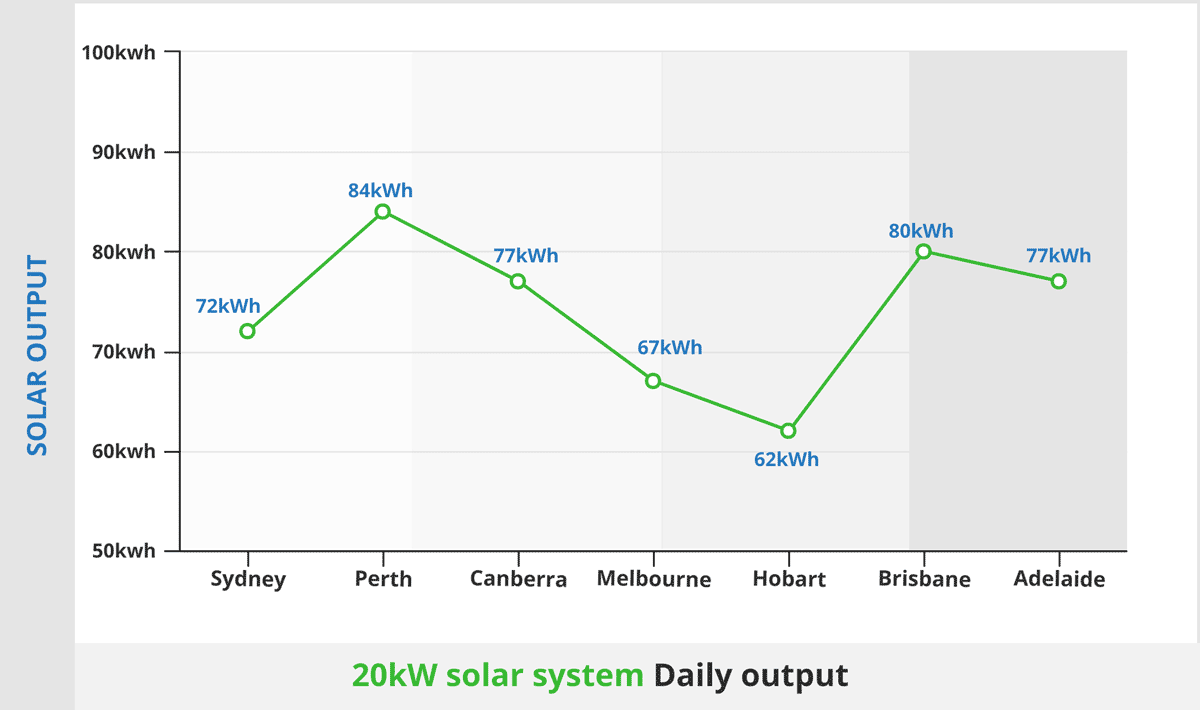Home Commercial Solar 20kW Commercial Solar System Cost
20kW Commercial Solar System: Cost Guide
The 20kW commercial solar system is perfect for a range of mid-sized commercial businesses and manufacturing plants.
You can expect to pay around $18,769 for a 20kW system installed. Prices can vary wildly depending on the quality of panels you install and the company that quotes the job.
The above price is after you have received your government rebate ($7,585 for 20kW systems) and does not include the price for battery backup.
Table of Contents
ToggleRebate on 20kW solar system
Under the federal government’s solar rebate programs, commercial solar systems generally receive more rebates than residential systems. This is because commercial systems are bigger and generate more solar energy daily.
Commercial solar owners can receive these rebates by claiming their Small-scale technology certificates (STCs). The more of these certificates you have, the more rebates you’ll receive for your solar system.
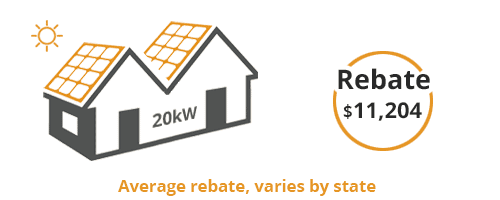
The 20kW commercial solar system enjoys some generous rebates. However, the total amount of rebates you’ll receive will largely depend on your location.
This is because the STCs are given depending on the sunlight intensities of your area. Therefore, states with higher sunlight intensities tend to receive more rebates than those in low-intensity states.
This program, which started in 2017, is being phased out by 1/15th each year and it’s set to end by December 2030.
Here’s a rough estimate of how much rebate you can expect for your 20kW solar system.
| State | System Size | Zone | Zone rating | Rebate |
|---|---|---|---|---|
| New South Wales | 20kW | 3 | 1.382 | $7,585 |
| Queensland | 20kW | 1 | 1.622 | $8,921 |
| South Australia | 20kW | 3 | 1.382 | $7,585 |
| Victoria | 20kW | 4 | 1.185 | $6,485 |
| Western Australia | 20kW | 3 | 1.382 | $7,585 |
| ACT | 20kW | 3 | 1.382 | $7,585 |
| Northern Territory | 20kW | 1 | 1.622 | $8,921 |
| Tasmania | 20kW | 4 | 1.185 | $6,485 |
In some of these states, you can also apply for the state rebate program and supplement the federal rebates. The most popular states with incentive programs include Victoria, New South Wales, South Australia, and Western Australia.
Feed-in tariff on 20kW solar system
Like the rebate amounts, the total feed-in tariff income you’ll receive will largely depend on your location. But while the rates might be different, the feed-in tariff is one of the best ways to improve the ROI of your 20kW commercial solar system and increase your earnings.
This scheme allows you to receive credits or incentives for selling back your surplus electricity to the grid. Your energy company then pays you per kilowatt, for all the surplus power you send to the grid.
On average, most utility companies will pay you feed-in rates of between 8c – 20c per kilowatt. However, these rates could go as high as 29c during peak hours and 7c during off-peak hours.
Since the 20kW solar system generates so much power during the day, you can be sure of substantial incentives from the feed-in tariffs.
Keep in mind; there are no fixed feed-in rates. Different companies offer different feed-in rates depending on your location in the country. You should therefore strive to get the best rates for your exported solar. Visit this page for more details on the feed-in tariff rates for your state.
How long until a 20kW solar system pays for itself?
Around 3 – 5 years. One of the main benefits of investing in commercial solar systems is their quick payback period. Your 20kW commercial solar system usually offsets its initial investment costs by the fourth year. This gives you enough time to enjoy 20 – 25 years of savings from ‘free energy’.
However, several factors affect how fast your 20kW commercial solar system can pay for itself. These include your location and your energy consumption habits.
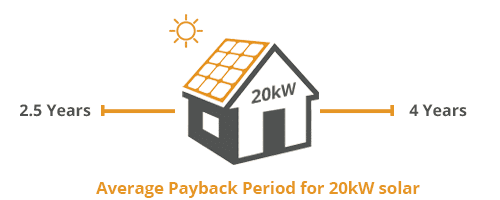
As earlier mentioned, the price of 20kW solar systems varies between states because of the different rebates offered.
Therefore, in states where their cost is higher, solar systems tend to have a longer payback period than in states where panels are cheaper.
Businesses that consume more energy during the day also record faster payback periods. You should, therefore, consume more of your generated power to improve the system’s ROI.
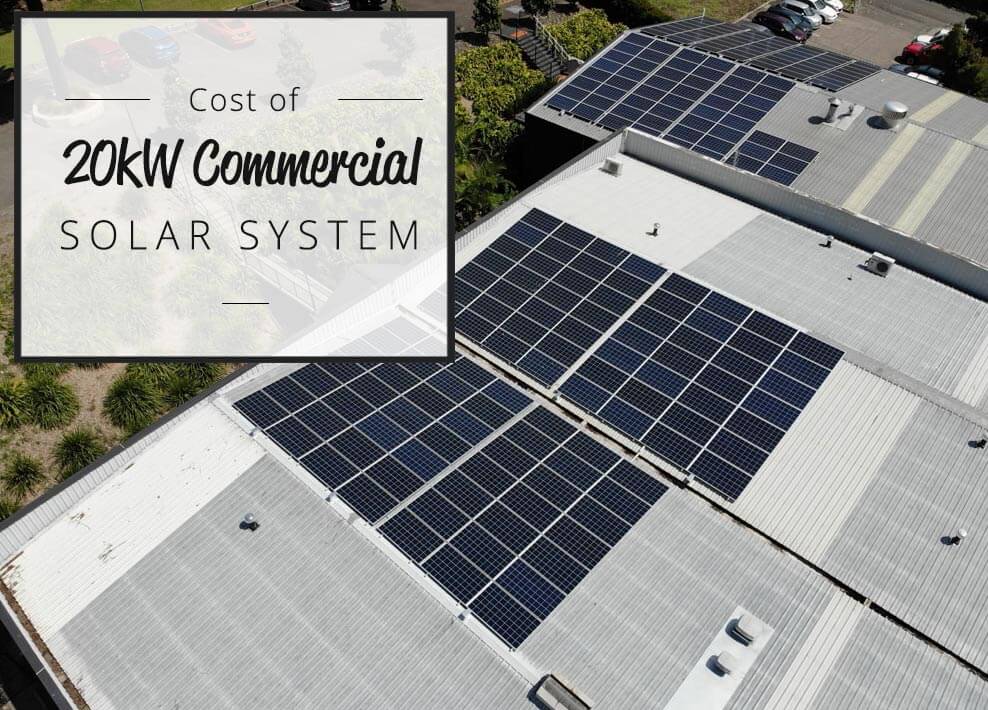
How many panels will I need for 20KW?
Around 68 solar panels. The 20kW commercial solar panel is quite big compared to most residential solar panels. It, therefore, uses a lot more panels. The actual number you might need for your system will depend on the size (rating) of panels you choose.
The formula for this total simply requires you to divide your system’s total size (20,000W) by the size of solar panels you choose.
If you choose solar panels with higher energy ratings, e.g., 300W, 330W or 350W you’ll need only 67, 60, and 58 panels respectively. However, with lower-rated panels, e.g., 250W, 260W, 275W, you’ll need 80, 77 and 73 solar panels respectively.
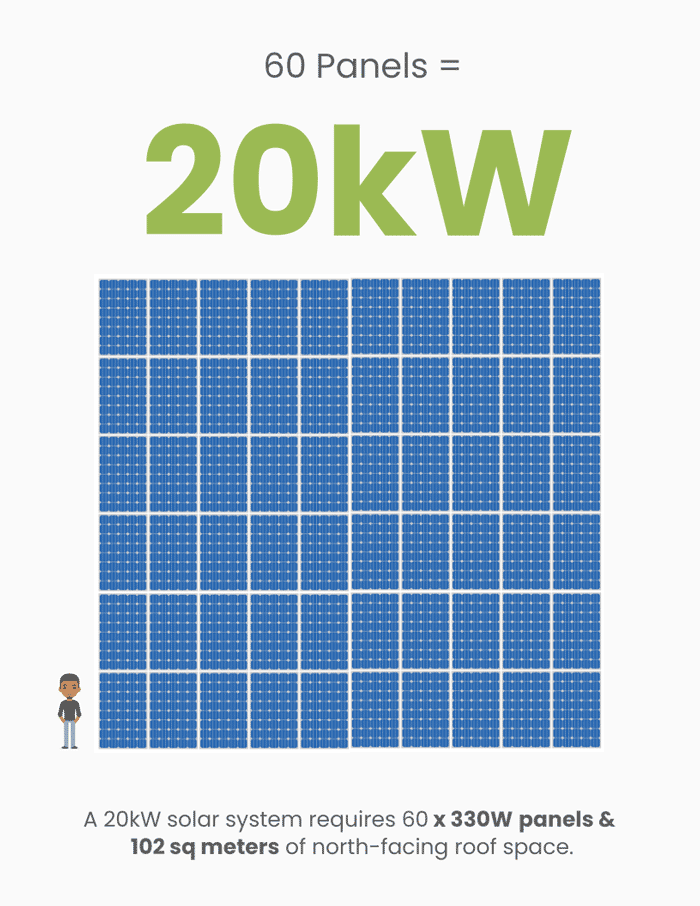
How much roof space is needed for a 20kW solar system?
Assuming you’re using the average 1.7m x 1m solar panels, you’ll need anywhere from 98.6 m2 to 136 m2 of roof space. This is assuming you use the 58 – 80 solar panels from the 250 – 350W.
Your roof shape, condition and orientation may also demand more roof space than expected. Get an expert installer to assess how much space you’ll need.
You might also have to remove some of the things mounted on your roof to create more space. Homes with flat roofs may also need more space as they have to make room for tilting frames.
All things considered; you may end up requiring around 150m2 of roof space.
Battery storage for 20kW solar system
When looking to maximize on your 20kW commercial solar system, investing in solar battery storage is a good option. Solar batteries ensure that your business can consume nearly all of its generated energy, thus increasing your savings.
Battery storage is also crucial during power blackouts and cloudy or rainy days, as it ensures your business operation doesn’t stop.
What Battery size do you need?
If you’re going to invest in solar batteries, you need to know how to size one correctly to suit your solar system.
The good news is most commercial places of business use the bulk of their energy while the sun is shining. This is different for residents who need to store most of their power for the night.
A 20kW system produces 75kW of power during the day, you might need to store 30-40 % of that for use before the sun comes up and after the sun goes down.
You’ll need to store 25-30kW of power which is 2 x 14kW Tesla Powerwalls. Each costs $12,500.
Do I need a solar battery?
Because the cost of solar storage batteries is still very expensive in Australia you might be best oversizing your system and taking advantage of solar feed-in tariffs.
This allows you to use the grid as your own personal virtual battery.
Having a solar battery may be worth it for businesses that need 24/7 power to run. It could also work if you want to go off-grid – but with a larger battery.
20kW solar inverter for commercial solar
For a 20kW solar system, you’ll only require 1 – 2 inverters depending on the installation design and your location. You’ll have to choose between one 20,000W inverter or two 10,000W inverters.
The inverter size should always be as close to the size of your commercial solar system as possible.
However, you should consider your location before settling on an inverter size. If you’re in an area with a lot of sunlight, stick to a 20,000W inverter or a slightly bigger one due to the high energy generation.
If you’re in an area with lower sunlight intensity, an inverter slightly smaller than 20,000W should work. This is because the solar system’s overall output is lower.
Most installers recommend having two inverters for better efficiency and to ensure that a fault in one inverter doesn’t affect your entire energy production.
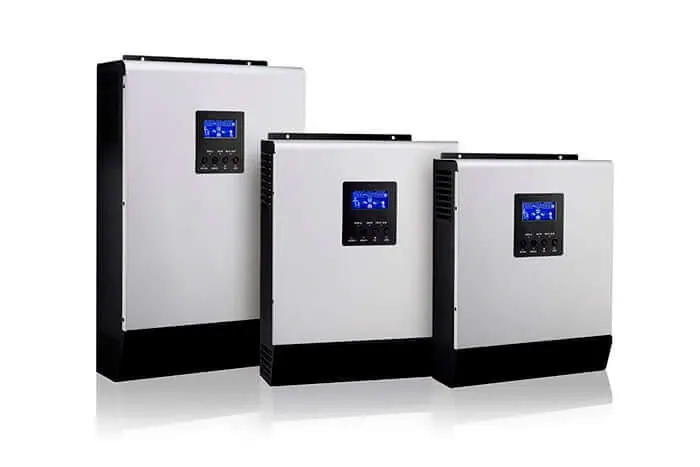
What is the daily output of a 20kW solar system?
A typical 20kW commercial solar system in Australia generates anywhere from 62kWh to 84kWh daily. This output varies daily depending on your location and the time of the year.
Different states across Australia receive varying power output from the 20kW solar system because of the varying sunlight intensities. Cities with higher sunlight intensities like Brisbane and Perth generate more power than Sidney and Melbourne.
Another key factor that affects your 20kW solar system output is the orientation and angle of solar panels. North-facing panels are the most efficient in Australia, while panels facing the East-West direction lose efficiency by nearly 20%.
Solar panels inclined at around 30 degrees also generate more power than panels on flat roofs. Look out for shading as well. It reduces the efficiency and overall output of solar panels.
Here’s a rough estimate of the daily output from a 20kW commercial solar system in different cities across the country.
| City | Solar Output |
|---|---|
| Sydney | 72kWh |
| Perth | 84kWh |
| Canberra | 77kWh |
| Melbourne | 67kWh |
| Hobart | 62kWh |
| Brisbane | 80kWh |
| Adelaide | 77kWh |
What is the monthly output of a 20kW solar system?
Just like the daily output varies, the overall monthly output of your 20kW solar system fluctuates. The average monthly output ranges between 1,860kWh – 2,520kWh depending on your state in the country.
The overall output of the solar panels is usually highest during summer, October to February, because the days become longer and the sun is highest in the sky.
In winter, from June through to August, the solar panel’s monthly output is the lowest. This is because the days become shorter and the sun is much lower in the sky.
How much money can I save with a 20kW commercial solar system?
With a well-installed 20kW commercial solar system, you can save up to $10,000 every year. Since it generates so much power daily, you can save money by consuming the generated power, storing it for later use, and even the feed-in tariff.
In general, how much you save with commercial solar systems depends on your energy consumption and the current cost of electricity.
The more power you consume from your solar systems, the more money you save. This also includes the incentives you receive from sending your excess power to the grid.
Additionally, the rising electricity costs in the country play a key role in increasing your savings. (We count your savings as the total amount of grid power that you avoid using by going solar).
How do I calculate my solar savings?
Here’s an easy way to help you calculate how much savings you can have annually.
We’ll take a business in Brisbane which consumes about 80% of its power during the day. The electricity cost in Brisbane is around 28c/kWh, and the average feed-in rate is about 10c/kWh.
With the average daily output for a 20kW commercial solar system in Brisbane being 80kWh, this business consumes 64kWh daily. This converts to around 23,360kWh annually.
In savings, this becomes: 23,360 x 0.28 = $6,540 annually.
The surplus generated power is 16kWh daily or 5,840kWh annually. If this is sent back to the grid, the business also receives: 5,840 x 0.10 = $584 in feed-in tariff income.
Your total saving for the year, therefore, becomes: $6,540 + $584 = $7,124.
With such savings, you’ll considerably cut down your power costs and reliance on power from the grid.
Do regular solar companies install commercial systems?
Yes, most solar companies do. Anything above 50kW will need a commercial solar installer for safe and accurate installation. Most local installers can also complete the job comfortably.
However, the Australian market is flooded with installers and solar companies, making it harder to find legitimate and qualified installers.
You should, therefore, be extra cautious when choosing a company to complete your commercial solar installation.
FAQs
How does solar power reduce your electricity bill?
There are three main ways in which solar panels can reduce your power bills. The main way is through reducing your reliance on power from the national grid. With businesses spending nearly 70% of their power during the day, their monthly bills will be drastically low.
Solar power also saves you money through the feed-in tariff scheme and the federal tax credits.
Do I need to pay tax on the income from a feed-in tariff?
Usually, no. The income from feed-in tariffs, based on residential solar systems is not taxable in Australia. However, feed-in tariffs income may be taxable if the solar system is on a commercial building.
So, if you use your building to make a profit of any kind, then your feed-in income is taxable. Nevertheless, this law is still quite vague and so, make sure you consult an expert before ruling out the taxes.
How much space is required to install a commercial solar power system?
Different commercial solar systems occupy varying spaces depending on their size. For instance:
- The 20kW commercial solar system occupies around 160m2
- The 30kW commercial solar system occupies around 250m2
- The 50kW commercial solar system occupies around 400m2
- The 100kW commercial solar system occupies around 750m2
Is living off the grid illegal in Australia?
No! Living off the grid is completely legal in Australia for both residents and businesses. You’ll, however, need a big solar system and battery storages to ensure adequate power supply, and water tanks for storage.
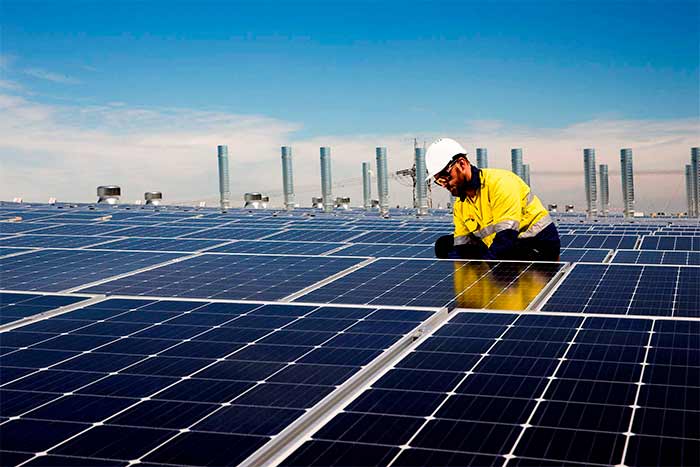
Compare Solar Panel Quotes
Table of Contents
Toggle










